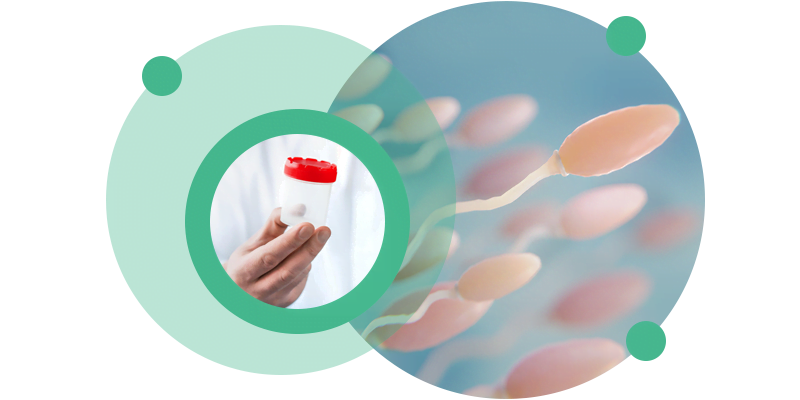Spermogram
A sperm analysis is the first complementary diagnostic test required to assess male fertility. It is a simple test to perform, but it must follow some basic collection and assessment rules in order to be credible and validated in an appropriate and reliable manner.
Therefore, for correct interpretation, it is essential that all laboratory work is standardized according to reference values. There is a consensus that current sperm analysis should follow internationally defined guidelines set by the World Health Organization.
The spermogram, in addition to including the verification of various components of the sperm at a qualitative and quantitative level, also allows the execution of additional tests of greater complexity.

About the Spermogram
A sperm analysis is the first complementary diagnostic test required to assess male fertility potential. It is a simple test that involves obtaining sperm ejaculated during masturbation and then processing it in a certified laboratory to assess certain parameters that will allow us to assess fertility potential as well as general and specific anomalies in sperm production.
The main parameters to be assessed are sperm concentration, as well as their motility and morphology. The total volume of the ejaculate, pH, viscosity, color and liquefaction time are also assessed. It is essential that all laboratory processing of the sperm obtained is standardized according to the reference values, and the assessment must be carried out within 30 minutes after ejaculation.
Current sperm analysis should follow international guidelines defined by the World Health Organization. The values considered as reference are:
- Ejaculated Volume – Greater than 1.4ml
- pH – Greater than 7.2
- Sperm Concentration – Greater than 16 million per ml
- Total Motility – Greater than 42%
- Progressive Motility – Greater than 30%
- Morphology (normal forms) – Greater than 4%
- Vitality (% of live sperm) – Greater than 54%
It is essential to remember that we are talking about reference values and they should not be interpreted as a source of clear and definitive diagnosis, but rather as a form of diagnostic and therapeutic guidance. In other words, there are several situations of male infertility in which all of these parameters are normal, as well as other situations of proven paternity in which there may be one or more alterations in each of these seminal parameters evaluated.
The spermogram also allows, in specific situations and according to very clear indications that vary from man to man, the evaluation of other seminal parameters, namely the presence of leukocytes to detect situations of infection of the seminal tract, dosages of some substances derived from the prostate and seminal vesicles, present in the ejaculate and responsible for its better or worse quality, as well as evaluating the rate of fragmentation of the sperm DNA, this last parameter being internationally recognized today as fundamental for good effectiveness in the fertilization of the oocyte.
The purpose of performing a sperm analysis is to assess the man’s fertility potential. This test is included in the context of the evaluation of infertile couples.
By analyzing the parameters evaluated (and together with other complementary diagnostic tests), this exam allows an approach to the male reproductive system, allowing the best therapeutic approach to be chosen in order to allow a natural pregnancy, and in accordance with the woman’s reproductive potential.
Likewise, in more specific situations, the sperm count will also facilitate decision-making regarding the best medically assisted reproduction technique to use, whether it be artificial insemination (AI) or in vitro fertilization (IVF), using or not the intracytoplasmic sperm injection (ICSI) methodology.
A spermogram is absolutely indicated in all situations of conjugal infertility.
Infertility is defined as the inability of a sexually active couple without any type of contraception to achieve a spontaneous pregnancy within 1 year. Primary infertility refers to couples who have never had children and are unable to become pregnant after at least 12 consecutive months of sexual intercourse without the use of contraceptive methods. Secondary infertility refers to infertile couples who have managed to become pregnant at least once before (with the same or another sexual partner).
About 15% of couples do not get pregnant within 1 year and seek medical treatment for infertility. One in eight couples encounter problems when trying to conceive a first child and one in six when trying to conceive a subsequent child.
In 50% of childless couples, a factor associated with male infertility is found, usually together with abnormal sperm parameters. Therefore, in all infertile couples, the man should be evaluated by a urologist specialized in male reproduction (andrology differentiation), with a spermogram being the initially recommended laboratory diagnostic method.
A sperm count is also indicated for all men who undergo bilateral vasectomy as a definitive contraceptive method. After the procedure, regular ejaculatory activity should be maintained and a sperm count should be performed after approximately 3 months. The result should indicate a complete absence of sperm in the ejaculate (azoospermia), confirming the success of the procedure and allowing unprotected sexual intercourse.
There are other situations, particularly in oncological cases, in which a sperm count is essential. When there is a need for treatments that require the surgical removal of a testicle, as well as radiotherapy and/or chemotherapy, cryopreservation of sperm for future fatherhood is essential, given the possibility of irreversible damage to sperm production caused by this type of treatment.
Therefore, it is essential to check sperm parameters in order to validate the possibility of cryopreserving quality sperm before carrying out this type of treatment.
Fundamentally, a sample is required that allows for a correct laboratory evaluation. A period of sexual abstinence (without ejaculation) of 3 to 5 days must be respected. The ejaculated sample must be collected in its entirety in a sterile container. The collection is carried out by masturbation – avoid coitus interruptus, as well as the use of condoms and any type of intimate lubricant and/or spermicides. vérifier les paramètres du sperme afin de valider la possibilité de cryoconserver du sperme de qualité avant de réaliser ce type de traitements.
Yes, but it is not the ideal procedure. The ejaculate must be assessed within 30 minutes of collection and there must be no temperature variations during transport. It is recommended that it be kept close to the body during transport to the Reproduction Center to avoid these variations as much as possible.
Therefore, it is recommended that the collection be carried out at the Reproduction Center facilities where there is usually a reserved and quiet area for this purpose, and it is possible to use auditory and visual stimuli of an erotic/sexual nature, in order to allow adequate stimulation that promotes the achievement of orgasm and ejaculation.
Therefore, we only make this rule easier in very specific situations where the man has difficulty in obtaining ejaculate in an environment outside of his comfort zone. The container for collection is sterile and provided by the Reproduction Center, but a basic urine collection container can also be obtained from a pharmacy.
If the sperm analysis is normal according to WHO criteria, a single test is sufficient. In any other circumstances, at least 2 spermograms are always necessary to assess the stability and validation of the test. If the results are abnormal in at least two tests, further andrological investigation is indicated. It is important to differentiate between the following findings:
- Oligozoospermia: 16 million sperm/ml
- Azoospermia: Absence of sperm in the ejaculate. In azoospermia, sperm analysis may show normal ejaculate volume and azoospermia should be confirmed after centrifugation. A recommended method is to centrifugation of the sperm at 3,000 g for 15 minutes and a thorough microscopic examination under a phase contrast light microscope at 200X magnification. All samples should be stained and re-examined microscopically. This is to ensure that even small numbers of sperm can be detected and potentially used for intracytoplasmic sperm injection (ICSI), thus eliminating the need for surgical intervention.
- Asthenozoospermia: 30% progressively motile sperm
- Teratozoospermia: 4% normal forms
None of the individual sperm parameters (e.g., concentration, morphology, and motility) is diagnostic per se of infertility. Frequently, all three anomalies occur simultaneously, which is defined as oligoasthenoteratozoospermia (OAT) syndrome.
As in azoospermia (i.e., the complete absence of sperm in the ejaculate), in severe cases of oligozoospermia (sperm < 5 million/ml), there is an increased incidence of obstruction of the male genital tract and genetic anomalies. In these cases, a more comprehensive assessment of the hormonal profile may be useful to more accurately and differentially diagnose the different pathological conditions.
Frequently Asked Questions
Yes, it is more common than usually reported. Although it is not a common situation, there are cases in which the pressure of “having to comply” to provide an ejaculate sample can psychologically inhibit the orgasmic process and thus prevent the sample from being obtained. In these situations of great stress, the presence of a partner is suggested for better erotic stimulation, and also to help with the physical and/or psychological relaxation component. Exceptionally, the collection site can be the person’s own home or a hotel room, where the “adverse environment” conditions can be diluted. Being nervous, stressed or inhibited will not alter the analytical results of the test.
You can consult CETI’s price list here.
The test result itself does not change. However, if erectile dysfunction is moderate/severe, there may be increased difficulty in achieving orgasm and ejaculation. Your Urologist/Andrologist will be able to help you overcome this situation, as well as others that may arise at this time or that were already present previously.
No, it has no relevance whatsoever. Even men with documented premature ejaculation do not exhibit different values in sperm analysis parameters when compared to men who present themselves within the general standards of the so-called “normal” ejaculatory time.
In very specific situations, the clinical staff at the Reproduction Center may request a sperm collection very close to the previous one. However, as a standard situation, the next collection must respect the usual period of sexual abstinence (3 to 5 days).
